
NGC 39 is an unbarred spiral galaxy in the constellation Andromeda. It was discovered in 1790.

NGC 50 is an elliptical galaxy in the constellation Cetus with a diameter of 170,000 light-years. It was discovered in 1865 by Gaspare Ferrari. The galaxy is, in comparison to the Milky Way, about 1.5-2 times as large. It is also physically close to NGC 49.
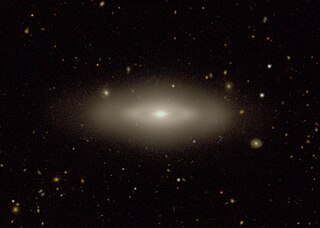
NGC 148 is a lenticular galaxy located in the constellation Sculptor. It is about 40,000 light years across. It is in a group of three galaxies along with MCG-5-2-16 and IC 1555. It is a Shapley-Ames galaxy.

NGC 459, also known as UGC 832, MCG 3-4-17, ZWG 459.24, and PGC 4665, is a spiral galaxy in the constellation Pisces. It was discovered on October 15, 1784, by William Herschel. It was described as being extremely faint by John Dreyer in the New General Catalogue.

NGC 507, also known as Arp 229, CGCG 502-67, MCG 5-4-44, PGC 5098, UGC 938, and V V 207, is a lenticular galaxy in the constellation Pisces. It was described as being "very faint", "pretty large", "round", "brighter in the middle", and "south of NGC 508" by John Dreyer in the New General Catalogue. The two galaxies are a part of the Atlas of Peculiar Galaxies, where NGC 507 is described as "Circular or near circular rings of small density difference."

NGC 7012 is a large, bright elliptical galaxy located about 380 million light-years away from Earth in the constellation Microscopium. NGC 7012 was discovered by astronomer John Herschel on July 1, 1834.
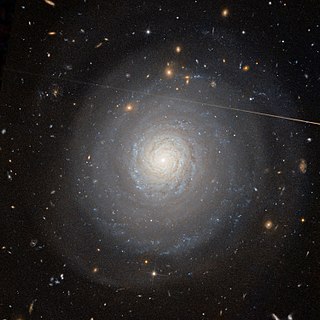
MCG+07-33-027 is an isolated spiral galaxy located about 330 million light-years away in the constellation Hercules. It has a very high rate of star formation which would make it a starburst galaxy. Normally, starburst galaxies are triggered by the collision of another galaxy. However most galaxies are in groups or clusters, while MCG+07-33-027 is solitary. Therefore, the cause of the starburst was not due to a collision or by the passing of a nearby galaxy and so the cause of the activity remains unknown.
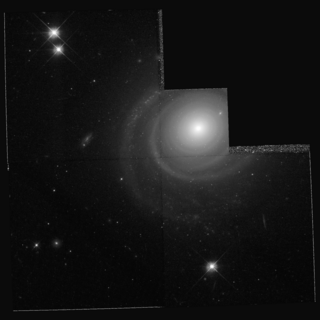
NGC 7096 is a grand-design spiral galaxy located about 130 million light-years away in the constellation of Indus. NGC 7096 is also part of a group of galaxies that contains the galaxy NGC 7083. NGC 7096 was discovered by astronomer John Herschel on August 31, 1836.

NGC 468 is a spiral galaxy in the constellation Pisces. Located approximately 209 million light-years from Earth, it was discovered by John Frederick William Herschel in 1827.

NGC 479 is a spiral galaxy in the constellation Pisces. It was discovered by German astronomer Albert Marth on October 27, 1864. It is about 240 million light-years away from Earth.
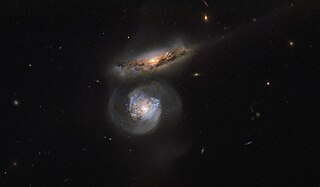
NGC 5765, also designated as MCG+01-38-004 and MCG+01-38-005, is a pair of interacting megamasers in the constellation Virgo, roughly 400,000,000 light-years (120,000,000 pc) away from Earth. NGC 5765B is active, and energy is released from the core, some of which is absorbed by a nearby cloud of water. The cloud then re-emits this energy as microwaves. These emissions were used to help redefine the Hubble constant.

NGC 6975, also known as NGC 6976, is a spiral galaxy in the constellation Aquarius. The object was discovered on 12 July 1864 by the German astronomer Albert Marth.

NGC 2998 is a barred spiral galaxy located in the constellation Ursa Major. It is 195 million light-years away from the Earth. It is an intermediate spiral galaxy. Its stellar mass is about that of the Milky Way.

NGC 4066 is an elliptical galaxy located 340 million light-years away in the constellation Coma Berenices. The galaxy was discovered by astronomer William Herschel on April 27, 1785. NGC 4066 is a member of the NGC 4065 Group.

NGC 4072 is a lenticular galaxy located 300 million light-years away in the constellation Coma Berenices. The galaxy was discovered by astronomer Ralph Copeland on April 3, 1872 and is a member of the NGC 4065 Group.
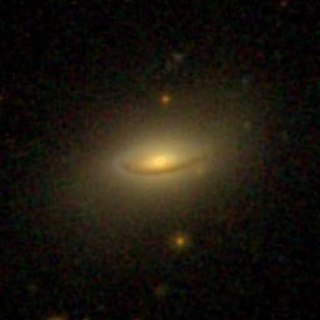
NGC 4074 is a peculiar lenticular galaxy located 310 million light-years away in the constellation Coma Berenices. It was discovered by astronomer William Herschel on April 27, 1785 and is a member of the NGC 4065 Group.

NGC 3005 is an edge-on spiral galaxy in the constellation of Ursa Major, discovered by Bindon Stoney on January 25, 1851. It is a member of the NGC 2998 group, which also includes NGC 2998, NGC 3002, NGC 3006, NGC 3008, and a few others.
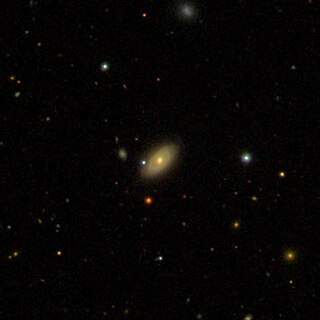
NGC 3008 is a lenticular galaxy with an active galactic nucleus in the constellation of Ursa Major, discovered by William Parsons and his assistants. It is about 40 thousand light years across, and with a recessional velocity of about 4,785 kilometers per second, is at a distance of 240 million light-years from the Sun.

NGC 600 is an emission-line galaxy in the constellation Cetus. It was discovered by William Herschel on 10 September 1785. The galaxy has a diameter of 70,000 light-years. It is also approximately 90 million light-years from the Milky Way.

NGC 4589 is an elliptical galaxy located in the Draco constellation. It is at a distance of about 108 million light-years away from the Earth. It is known by its designations PGC 42139 or UGC 7797.




















